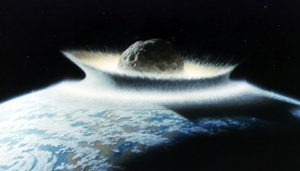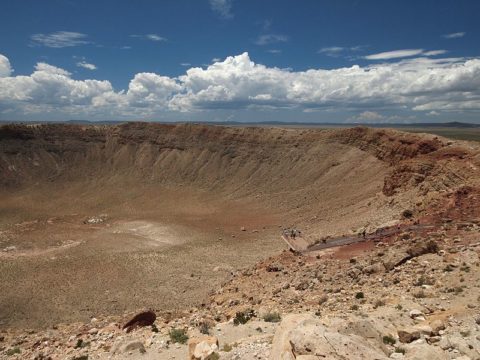A new analysis shows that nearly 100 stars buzz our solar system every million years — an effect that can hurl regular cosmic hailstorms of comets toward Earth.

NASA / Don Davis
Over the next 1.3 million years, an orange star will appear and then brighten dramatically in the night sky. Although currently invisible to the human eye, it will eventually be twice as bright as Sirius and even rival Mars and Jupiter. It will also move rapidly (astronomically speaking) across the sky. At 36 arcseconds per year, it will cross the width of the full Moon in roughly 50 years. That’s fast enough that an avid stargazer could discern its motion over the course of decades.
But the star will be more than just a stargazer’s hobby — it will be an omen that there’s trouble brewing in the heavens. Astronomers suspect that this star, better known as Gliese 710, will come so close that it will pass within the Oort cloud — that vast, faraway shell populated by trillions of comets. Such a close collision will jostle those comets from their peaceful orbits and potentially hurl them toward the Earth. And it wouldn’t be the first time.
Gliese 710 is just one in a number of stars that play billiards with the outer solar system. Now, Coryn Bailer-Jones (Max Planck Institute) has used data from the Gaia satellite to trace the paths of 300,000 nearby stars between 5 million years into the past and 5 million years into the future. His map of past and future close encounters has been published in the journal Astronomy & Astrophysics.
All in all, he saw that every million years, roughly 87 stars come within 2 parsecs (6.5 light-years) of the Sun. That means the stellar traffic is about twice as heavy as previous estimates.
Future Shock
Perhaps the most intriguing result — at least according to Paul Weissman (Planetary Science Institute), who was not involved in the study — is the aforementioned omen Gliese 710.
Joan García-Sánchez (Jet Propulsion Laboratory) and her colleagues first took note of this star in 1999. Then, based on data from Gaia’s predecessor, the Hipparcos satellite, they estimated that Gliese 710 would pass within 80,000 astronomical units of the Sun. That’s just beyond the outer Oort cloud. But the latest estimate nudges that distance to just 16,000 astronomical units, placing it firmly within the inner Oort cloud. That’s the difference between a bug that flies close to your pumpkin latte and one that cannonball dives into it.
Although it’s hard to predict just what that might mean for the inner solar system, Weissman thinks that “it’s likely to cause a much more substantial comet shower.” The latest estimate suggests that the number of comets entering the solar system will increase by a factor of 100, he argues. With so many comets traveling amongst the planets and their respective moons, it’s likely that 90 comets will make it through the solar system unscathed, while 10 comets won’t be so lucky: They will collide with planetary bodies head on.
And these won’t be any ordinary collisions. Comets are notably larger than asteroids (which cause the most impacts) and are therefore much more dangerous. Weissman once calculated that had Comet Hale-Bopp slammed into Earth, its effect would have been 10 times as extreme as the asteroid that hastened the demise of the dinosaurs.
Eric Mamajek (Jet Propulsion Laboratory), however, who was also not involved in the study, remains on the fence. He draws on Hurricane Harvey to argue that the worst-case scenario is one where a massive star comes in very close and is very slow-moving. “You don't want a Category 4 storm coming close to a population center and then just sitting,” he says. “And it's the same thing for a massive star passing through the Oort cloud.”
Luckily, Gliese 710 isn’t terribly massive. In fact, it’s about 60% as massive as the Sun. Unluckily, it’s moving relatively slowly. So Mamajek, unsure of what the star’s effect on the Oort cloud might be, did a quick back-of-the-envelope calculation. He found that it sits at the border between a star that has a negligible effect and one that can stir up the inner Oort cloud enough to send comets our way.
Pinpointing Further Culprits
Bailer-Jones didn’t find any stars that came closer than Gliese 710, which he admits was a bit of a disappointment. “That's always the hope that you find something unexpected and surprising,” he says. But he is hopeful that he will have better luck in the future. “There will be closer encounters, I’m quite sure of it,” he says. “It’s just that Gaia doesn’t have the faintest stars yet.”

Wikipedia / Ken Thomas
So with the next Gaia date set slated to be released in April, 2018, Bailer-Jones will probe more and more stars. With so much extra data, he suspects that he will be able to predict close encounters over the course of 25 million years in both directions (as compared to the five-million-year estimates he did with this study).
That’s roughly 40 million years short of the impact that hastened the demise of the dinosaurs. As such, he won’t be able to pin down the culprit for that extinction yet. In fact, that one might remain a mystery for the foreseeable future. Assuming that a star did jostle the impactor free from the Oort cloud, that star has definitely left the crime scene — it would already be on the other side of the galaxy.
But Bailer-Jones thinks it might be possible to find a correlation between a nearby runaway star and an impact crater in recent history. Of course, given how little we know about the Oort cloud, it would have to remain just that: a correlation. But it does mean that one day you might be able to point toward a star that’s rapidly speeding away from our solar system and say that it might have sent a comet crashing into our planet.
Reference:
C.A.L. Bailer-Jones “The completeness-corrected rate of stellar encounters with the Sun from the first Gaia data release.”Astronomy & Astrophysics.
 7
7









Comments
David-Smith
September 7, 2017 at 10:34 am
Does Gliese 710 have an Oort cloud of its own? If so, how would that affect predictions of impacts here?
You must be logged in to post a comment.
Anthony Barreiro
September 8, 2017 at 4:26 pm
But with lots more big comets passing through the inner solar system, the skywatching would be pretty dramatic!
You must be logged in to post a comment.
Lindsay
September 8, 2017 at 9:04 pm
What about the increase in solar radiation hitting the earth from a star passing through the Oort Cloud?
You must be logged in to post a comment.
james-ball
September 9, 2017 at 2:24 pm
If it only passes within 16,000 AU then it shouldn't have much effect. Neptune is only 30AU from the Sun and it is frozen, at 500 times farther away from Earth than the Sun is from Neptune, we shouldn't have much to worry about radiation wise.
You must be logged in to post a comment.
Andrew James
September 8, 2017 at 9:19 pm
You say: "Joan García-Sánchez (Jet Propulsion Laboratory) and her colleagues first took note of this star in 1999."
The history goes back much further. Gliese 710 was on Astronomy Picture of the Day : A Close Encounter of the Stellar Kind on 26th June 1997, where it says; "Gliese 710 poses no direct collision danger itself although its gravitational influence will likely scatter comets out of the Solar System's reservoir, the Oort cloud, sending some inbound. This future stellar encounter was discovered by researchers Joan Garcia-Sanchez and Robert Preston (JPL), and collaborators while studying stars in the solar neighborhood using data from the Hipparcos Astrometry Satellite. " Both Robert Preston and Joan announced this together.
The calculations and one of the earliest works specifically on such encounters started around, with the groundbreaking paper being: Matthews, R. A. J., "The Close Approach of Stars in the Solar Neighborhood " , Quarterly Journal of the Royal Astronomical Society, 35, 1, p.1, (1994) adsabs.harvard.edu/abs/1994QJRAS..35....1M This is one of the first mention of Oort cloud interaction, notably in this case, Alpha Centauri, which he finds 200,000 comets will be perturbed about two million years from now.
You must be logged in to post a comment.
Andrew James
September 11, 2017 at 5:50 am
You say: “Joan García-Sánchez (Jet Propulsion Laboratory) and her colleagues first took note of this star in 1999.”
The history goes back much further. Gliese 710 was on Astronomy Picture of the Day : A Close Encounter of the Stellar Kind on 26th June 1997, where it says; “Gliese 710 poses no direct collision danger itself although its gravitational influence will likely scatter comets out of the Solar System’s reservoir, the Oort cloud, sending some inbound. This future stellar encounter was discovered by researchers Joan Garcia-Sanchez and Robert Preston (JPL), and collaborators while studying stars in the solar neighborhood using data from the Hipparcos Astrometry Satellite. ” Both Robert Preston and Joan announced this together.
The calculations and one of the earliest works specifically on such encounters started around, with the groundbreaking paper being: Matthews, R. A. J., “The Close Approach of Stars in the Solar Neighborhood ” , Quarterly Journal of the Royal Astronomical Society, 35, 1, p.1, (1994) adsabs.harvard.edu/abs/1994QJRAS..35….1M This is one of the first mention of Oort cloud interaction, notably in this case, Alpha Centauri, which he finds 200,000 comets will be perturbed about two million years from now.
You must be logged in to post a comment.
Jim-Baughman
September 13, 2017 at 5:54 pm
What about Gliese 710’s effect on Kuiper Belt objects? Or the yet-to-be-observationally-confirmed Planet 9, whose own orbit swings it out to 17,000 AU? If G-710’s mass is 60% of the sun’s that’s no small number, and violently disrupting a Neptune-sized object’s orbit could have a catastrophic domino effect throughout the solar system.
You must be logged in to post a comment.
You must be logged in to post a comment.